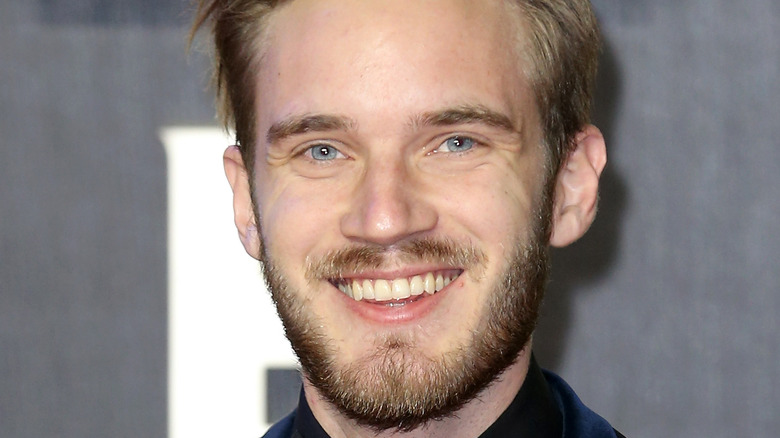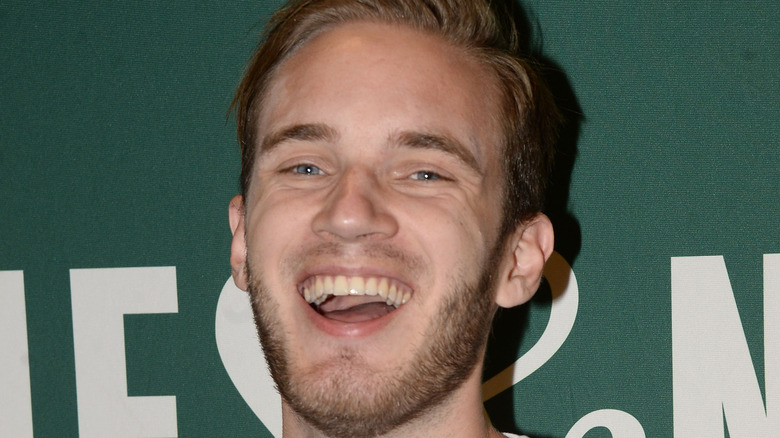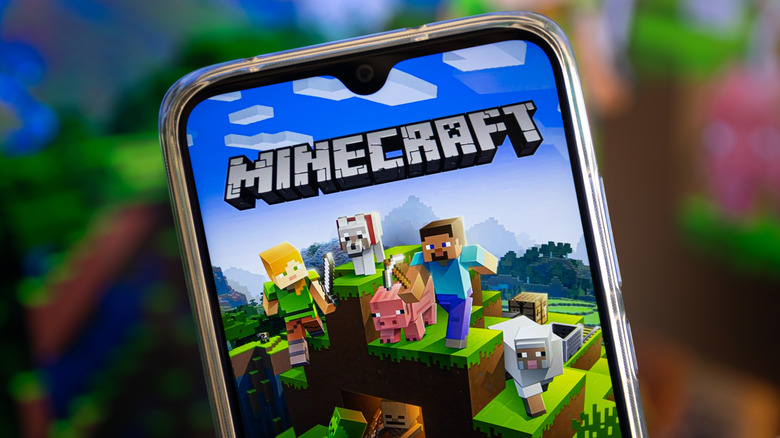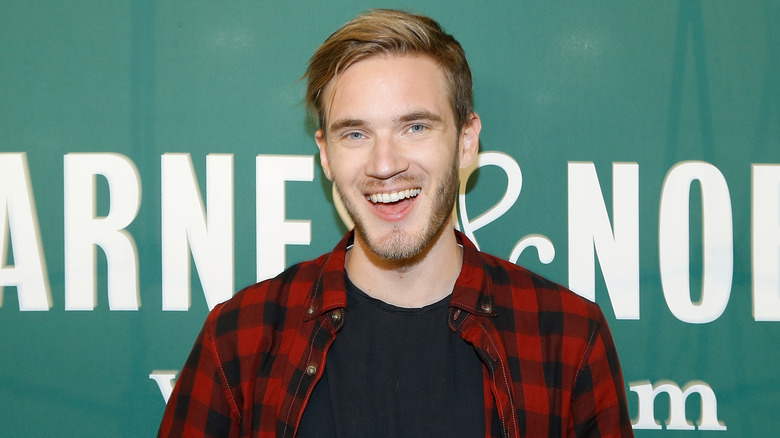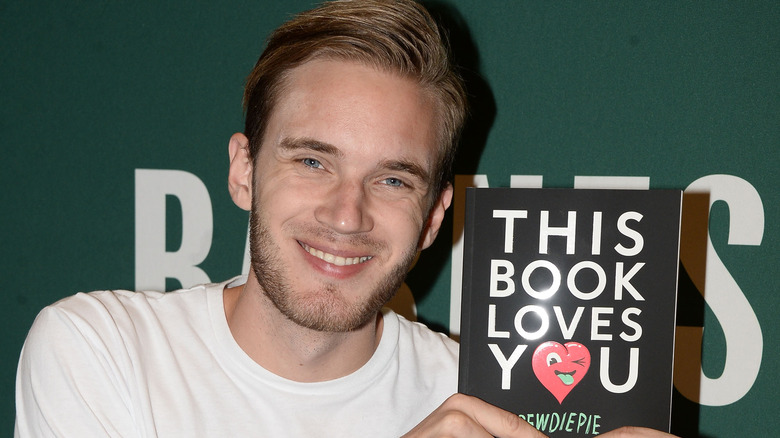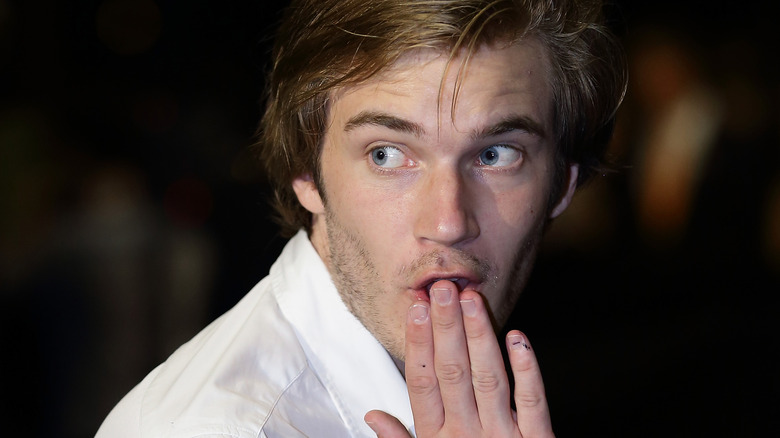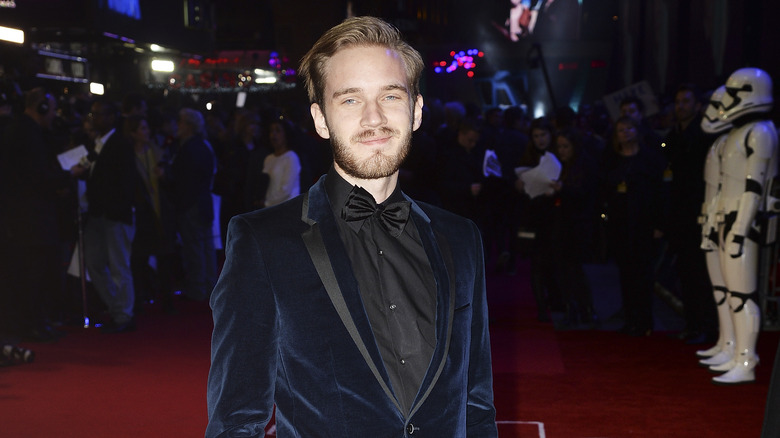The Untold Truth Of PewDiePie
With a career culminating in 110 million subscribers and countless controversies, Swedish YouTuber PewDiePie's 'about' section is pretty straightforward: "I make videos." The YouTuber, who's real name is Felix Kjellberg (via Business Insider) forayed into making walkthroughs of video games after quitting his degree in Industrial Economics and Technology Management in 2011 (via Independent). "Industrial management and economics — it was boring as hell. Everyone was boring as hell. I couldn't relate to f***ing anyone," he said in a video.
PewDiePie's climb up the YouTube celebrity ladder was inevitable; the YouTuber tapped into the overwhelming popularity of gaming franchises like "Call of Duty: Black Ops" and "Minecraft" that were gaining traction around 2011 (via Statista), around the same time PewDiePie started his channel. While the majority of his channel contained gaming walkthroughs accompanied by comedic reactions, Kjellberg began video commentary on memes, TikToks and other finds in the depths of internet culture.
However, the YouTube star's success didn't come easy — Kjellberg had to navigate financial troubles, controversies and more to get to the top.
PewDiePie supported his career by selling hotdogs
Kjellberg created a YouTube channel in 2010, and the persona PewDiePie with it. He was still attending Chalmers University of Technology to pursue his "boring" degree in Sweden, he soon realized it wasn't what he wanted to do with his life (via Business Insider). "I remember getting one subscriber was so exciting," he told ESPN, and he quit the school his mother had previously attended soon after.
His parents did not get his humor and refused to support the uncertainty that came with becoming a YouTuber. "The humor, I just don't understand it," his mom told a Swedish TV station in 2012. "I'll see in the comments, 'Check out 4:26. I've never laughed so hard in my life.' I'll go there and don't find anything that resembles a joke."
Misunderstood by his parents, the YouTuber had to fend for himself to continue creating. He did it by working at a hotdog stand — but he didn't need to for long. By the end of 2011, he had 60,000 subscribers.
Kjellberg tapped into YouTube's gameplay genre
Felix Kjellberg's subscriber base grew dependent on his infectiously manic reactions and commentary. Most of his early videos were a series of "Let's Play" videos that found its fans in a younger audience who he called "Bros" and fist bumped at the end of every video (via New Statseman). The genre of YouTube gameplay was relatively new at the time (via Emory Wheel) but watching skilled players punctuate their virtual worlds with unedited reactions had increasing appeal.
Kjellberg felt that he owed his success to his authenticity with his fans: "Unlike many professionally produced shows, I think I've established a much closer contact with my viewers, breaking the wall between the viewer and what's behind the screen," he told Polygon. "What I and other YouTubers do is a very different thing, it's almost like hanging around and watching your pal play games. My fans care in a different way about what they are watching."
PewDiePie is one of the highest-paid YouTubers
PewDiePie's over-the-top jokes and reactions earned him the attention of Hollywood media company Maker Studios in 2012. The company, known to help internet influencers with production, signed with PewDiePie that year. Later that year, PewDiePie hit a million subscribers and eclipsed 5 million subscribers by 2013 (via The New York Times), overtaking comedy duo Smosh as the most-subscribed to channel.
Maker Studios was then acquired by The Walt Disney Company, mainly for its association with PewDiePie (via ESPN). Dar Nothaft the VP of Polaris (part of Maker Studios) attributed his popularity to the fact that Kjellberg is a fan of the game just like his viewers, "People like Felix stand in for the fans. They're the voice of an aspirational fan. People don't want an 8/10 review; they want to share an 'Oh, my God!' moment" (via Polygon).
By 2019, PewDiePie became the first independent YouTuber to have a 100 million subscribers (via Business Insider). Later that year, Forbes estimated Kjellberg's earnings to be $13 million.
PewDiePie's video-game topped iOS charts
The YouTuber's success had him diversifying his content from exclusively playing action and horror games to commenting on other YouTubers, meme submissions and reviews. His channel became a mix of comedic relief and a spotlight for relatively unpopular games like "Goat Simulator." He also introduced weekly blogs that he titled "Fridays with PewDiePie" as a way for his fans to see the man behind the persona (via Business Insider).
Felix Kjellberg then went on to step outside the YouTube universe by releasing his own video game "PewDiePie: Legend of the Brofist" in 2015 (via TubeFilter), an allusion to his subscriber "bros." The video game topped iTunes' App Store list within two days of its release, causing him to release another one — "Tuber Simulator," where players become YouTube gaming streamers (via The Verge).
His popularity took him on-screen — nothing says success like giving a "bro-fist" to Stephen Colbert (via TubeFilter). Kjellberg also landed a guest role on adult animated series "South Park" (via YouTube) and had his mock-motivational book "This Book Loves You" get on The New York Times bestseller list.
He's has been involved in many controversies
However, PewDiePie's highs were met with many lows. The internet personality made some anti-Semitic "jokes" that cost him his association with Disney's Maker Studios in 2017; his reaction: "I didn't think they'd actually do it" (via Engadget). He defended himself in a since-deleted video, "We're going to have to start separating what is a joke, and what is actually problematic. Is a joke actually pure racism? Is something that would be considered a joke purely homophobic, or anti-Semitic and all these things? Context f***ing matters."
Controversy followed him into 2018, when his title as "Channel Most Subscribed To" was challenged by Indian music company T-Series (via Business Insider). In what became his most-viewed video "b**** lasagna," Kjellberg stated: "You tryna dethrone me from spot on number one, but you India, you lose, so best think you haven't won." With an audience much younger than Kjellberg himself, the Bro-Army made use of all channels to make sure PewDiePie remained at the top, including hacking unsecured printers with flyers that said simply, "1. Unsubscribe from T-Series. 2. Subscribe to PewDiePie" (via The New York Times). Many right-wing extremists and white supremacist "fans" also cited PewDiePie as inspiration for their violence. A white nationalist said, just before going on a shooting rampage, "Remember, lads, subscribe to PewDiePie."
PewDiePie's break from YouTube lasted 30 days
Amidst accusations of fostering racist sentiments, PewDiePie announced the end of the "Subscribe to PewDiePie" campaign in 2019. By the beginning of 2020, he'd "made up [his] mind" to take a break from YouTube, the first one in his decade-long career. He cited creator burnout, saying, "I'm tired. I'm feeling very tired, I don't know if you can tell," he said in the video. It may have also pointed to the fact that he had to keep up the persona of Pewds — funny and super extra. "You can't be crazy all the time," he told ESPN in 2015. "That's why my videos are all, like, five minutes — nobody can handle me for longer than that s***."
The YouTuber made it 30 days without creating content. He returned to the internet in February 2020, but this time, he's steered clear of media drama and has stuck to what he does best — play Minecraft and "staying awesome."
